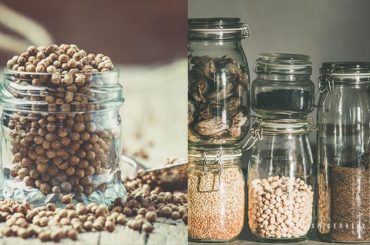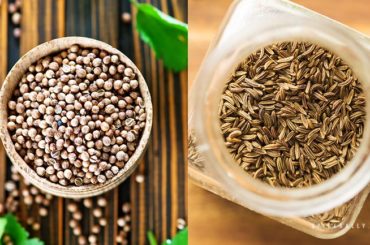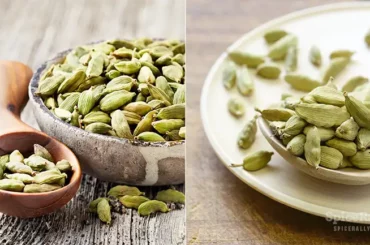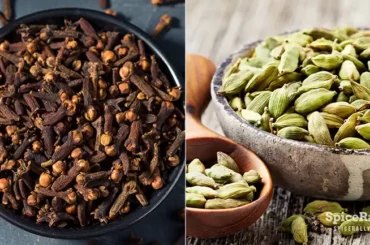Cinnamon is one of the most expensive yet extensively used spices in the world. And it has been able to perpetuate its distinctive place in our kitchen for over many years.
Saigon cinnamon is actually a sub-category of cassia cinnamon and comes from the Cinnamomum loureiroi tree. At the same time, Ceylon cinnamon or “true cinnamon” comes from the plant Cinnamomum verum, which is technically one of the main types of cinnamon. Although both are cinnamon varieties, they have some differences. And that is what we are going to showcase from our article this time.
So, keep reading to learn everything about Saigon cinnamon vs Ceylon cinnamon. And we have answers to every possible doubt that you may have about these two varieties.
Saigon Cinnamon Vs Ceylon Cinnamon
If you are a foodie who loves cooking every day or someone who is interested in culinary spices, you might have heard these two terms- Saigon cinnamon and Ceylon cinnamon a million times. Well, long story short, they both are cinnamon, but they are different. Starting from the source, from where they originated, and to their flavor and quality profiles, they are different indeed.

So, refer to this table below to clarify the differences between Saigon cinnamon and Ceylon cinnamon.
| Ceylon Cinnamon | Saigon Cinnamon |
| A main type of cinnamon. Also called “true cinnamon”. | A species of cassia cinnamon. That comes from Cinnamomum loureiroi plant. |
| Has a delicate, mild flavor with sweet and floral notes. | Intense and peppery flavor than Ceylon cinnamon. |
| Expensive and cannot be easily found in leading stores particularly in the USA. | Not that expensive compared to Ceylon cinnamon and is readily available in most shops. |
| Available as quills and powder. | Available as quills and powder. |
| Very low in coumarin level. | Possesses the highest level of coumarin of all the four Cinnamomum species marketed as cinnamon. |
| Healthier with less liver damage due to a lower level of coumarin. It lowers blood sugar, contains anti-inflammatory properties, and lowers LDL cholesterol. | High levels of coumarin can cause potential liver damage. But Saigon can give other health benefits just as much as Ceylon cinnamon would do. |
| Pairs with baked goods, desserts, and dishes that require less spices. | Pairs well with seasonings, spice blends, and dishes that employ several spices like curries and savory food items. |
| Also known as Cinnamomum zeylanicum. | Known by the names Vietnamese Cassia and Vietnamese Cinnamon. |
What Is Saigon Cinnamon?
Saigon cinnamon comes from the Cinnamomum loureiroi plant, which is basically a sub-category that falls under the cassia cinnamon umbrella. It is actually not a main type of cinnamon but a sub-type of one among the two main varieties, Cassia cinnamon. Even though Saigon is a species of Cassia, it comes from a different plant named Cinnamomum Cassia.
Saigon cinnamon is also known in names such as Vietnamese Cinnamon and Vietnamese Cassia since they are native to Vietnam. And, just like any other variety, Saigon cinnamon, too, is derived from the bark of the Cinnamomum loureiroi tree.
According to the chemical setup sources, this cinnamon type has the highest percentage of cinnamaldehyde. It is the combination that provides cinnamon with the taste and aroma that it is marked its place for. It contains 25% cinnamaldehyde. Moreover, Saigon cinnamon possesses the highest level of coumarin of all the four Cinnamomum species marketed as cinnamon, with one study witnessing 6.97 g/kg in a certified specimen.
However, coumarin is somewhat harmful to the liver and kidneys. Plus, petty neurological dysfunction was discovered in children exposed to coumarin during pregnancy.
Saigon cinnamon and Ceylon cinnamon can be different from each other, but did you know about the benefits you could get by using Saigon cinnamon? To satisfy your curiosity, click here for a fully detailed article on the benefits of Saigon cinnamon.
What Is Ceylon Cinnamon?
Ceylon cinnamon is also called True cinnamon and Cinnamomum zeylanicum. It is an evergreen plant that derives from Sri Lanka. And It is so-called because Sri Lanka used to be called Ceylon.
The most valuable part of the tree that Ceylon cinnamon comes from is the bark that is trimmed and dried before being marketed as sticks or pulverized down to a powder. Whole, lengthy pieces of this bark, identified as quills, are more diplomatic than broken pieces.
Generally, it is transported worldwide from Sri Lanka. But, it is not as typically utilized in a commercial intent as some other kind of cinnamon.
According to the cooking experts, Ceylon cinnamon can be employed for culinary pursuits as the best quality cinnamon, gaining victory by defeating all the other varieties. The main reason for this is that it is very low in coumarin level compared to other species and its high quality for many reasons.
Which Is Healthier, Saigon Or Ceylon Cinnamon?
Right now, in your kitchen, you may probably have either Saigon or Ceylon cinnamon. But, it is vital to be aware of which one is healthier to be added to your regular diet. Accordingly, coumarin levels can have an adverse effect on human health, particularly causing liver damage. And, shockingly, Saigon cinnamon contains the highest percentage of coumarin that possesses up to 1% coumarin. In the meantime, Ceylon cinnamon includes only a fraction, about 0.004%.
Therefore, when considering and comparing the amount of coumarin in both the cinnamon varieties and regarding the negative effects it would have on our health, we can suggest that Ceylon cinnamon can be the most healthier option of all time.
Health Benefits Of Saigon Cinnamon And Ceylon Cinnamon
Cinnamon, as a whole, as a spice, can literally have so many health benefits. However, although several studies have been conducted to show the health benefits that we could have when consuming cinnamon, studies or research to find out the health benefits of Saigon cinnamon haven’t been explicitly done.
Still, cinnamon consumption has the capability to provide us with the following health benefits:
- Contains beta-carotene and essential provitamins.
- Cinnamaldehyde contains anti-inflammatory properties that have the possibility to alleviate heat diseases, arthritis pains, and diabetes.
- Significantly reduces the amount of harmful (LDL) cholesterol levels in the body.
- Regulates the insulin response in the body and helps lower the risk of hypoglycemia or hyperglycemia circumstances.
Which Should I Use In Cooking? And When?
Now, after learning the facts about Saigon cinnamon vs Ceylon cinnamon pretty well, the next question most of us get is which one we should use in cooking and when to use it. Or, can we substitute from one another?
Well, when considering the flavor profile of Ceylon cinnamon, we see that it has a delicate, mild flavor with sweet and floral notes. Therefore, Ceylon cinnamon goes really well with baked goods, desserts, and food that requires a minimum amount of spices and flavorings. So, when used that way, you can get the best flavor out of it. And, that is why the famous American writer and musician Daniel Handler has said that:
“Anyone who gives you a cinnamon roll fresh out of the oven is a friend for life!”
While on the other hand, Saigon cinnamon, which is a type of Cassia, is way more pungent and peppery than Ceylon cinnamon. It usually pairs well with foods that employ a number of spices like curries and spice blends like Garam Masala and Chinese Five Spice Mix.
However, substituting them with each other is not much of an issue unless a certain recipe calls for a particular type of cinnamon specifically. There you should be careful since replacing could revise the genuineness of the entire dish.
Gathering Everything Into One Place…
Saigon and Ceylon cinnamon both are widely used spices in many cuisines around the world. But, although they are both types of cinnamon, they still have distinctive variations.
However, Saigon cinnamon is a sub-category that falls under the umbrella of cassia cinnamon, while Ceylon cinnamon is one primary type and is often considered “True Cinnamon”.
Over and above, despite the differences, Saigon and Ceylon cinnamon, both are great additives that improve the taste of any dish they are used to.




